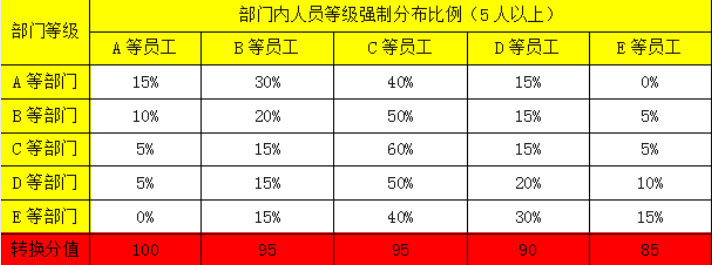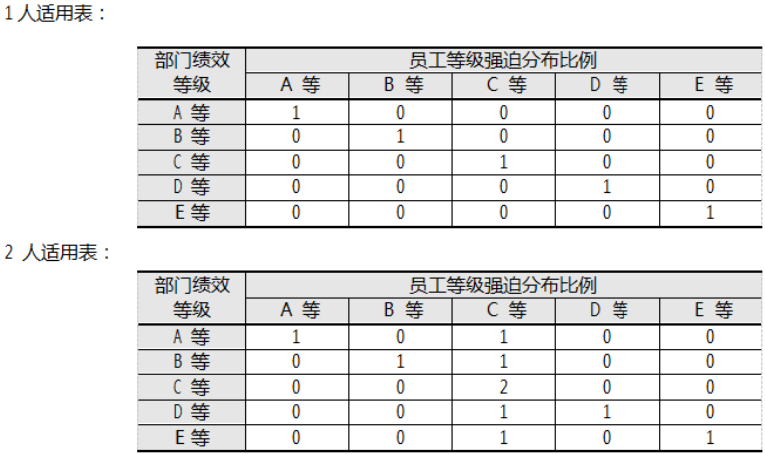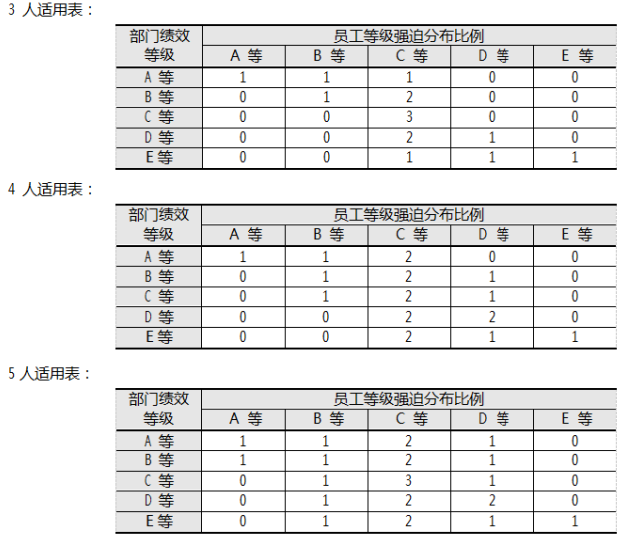Forced distribution is often used in performance management, such as:

As shown in the figure, this table is applicable to the number of departments with more than five people, for example:
Zhang San's department performance is A,
It belongs to A department,
There are 20 people in the Department,
Zhang San ranks the 8th in the Department;
According to this table, Zhang San belongs to class B employees and can be converted to 95 points;
However, if the number of departments is less than 6, the ranking rules are as follows:

Introduce rulebook rule engine, code structure:

pom.xml
<?xml version="1.0" encoding="UTF-8"?> <project xmlns="http://maven.apache.org/POM/4.0.0" xmlns:xsi="http://www.w3.org/2001/XMLSchema-instance" xsi:schemaLocation="http://maven.apache.org/POM/4.0.0 http://maven.apache.org/xsd/maven-4.0.0.xsd"> <modelVersion>4.0.0</modelVersion> <groupId>com.youway</groupId> <artifactId>kpi-rulebook</artifactId> <version>1.0-SNAPSHOT</version> <properties> <project.build.sourceEncoding>UTF-8</project.build.sourceEncoding> <project.reporting.outputEncoding>UTF-8</project.reporting.outputEncoding> <java.version>1.8</java.version> <easy-rules.version>3.1.0</easy-rules.version> <slf4j.version>1.7.25</slf4j.version> <rulebook.version>0.9.1</rulebook.version> </properties> <dependencies> <dependency> <groupId>com.deliveredtechnologies</groupId> <artifactId>rulebook-core</artifactId> <version>${rulebook.version}</version> </dependency> <dependency> <groupId>org.slf4j</groupId> <artifactId>slf4j-simple</artifactId> <version>${slf4j.version}</version> </dependency> <dependency> <groupId>org.projectlombok</groupId> <artifactId>lombok</artifactId> <version>1.16.8</version> <scope>provided</scope> </dependency> </dependencies> </project>
Rule execution test code Launcher.java
package com.youway; import com.deliveredtechnologies.rulebook.NameValueReferableMap; import com.deliveredtechnologies.rulebook.FactMap; import com.deliveredtechnologies.rulebook.model.runner.RuleBookRunner; /** * Rule execution test code * @author youway * */ public class Launcher { public static void main(String args[]) { RuleBookRunner ruleBook = new RuleBookRunner("com.youway.rules"); //Load all rules in the development package NameValueReferableMap facts = new FactMap(); facts.setValue("num", 5); //Department number: 5 facts.setValue("deptLevel", "B"); //Department performance rating: B facts.setValue("rank", 3); //Rank of the employee in the department evaluation: 3 ruleBook.run(facts); ruleBook.getResult().ifPresent(System.out::println); //Print output of rule execution } }
Result type of rule execution output Response.java
package com.youway.pojos; import lombok.Data; /** * Force distribution results based on the output of rules * @author youway * */ @Data public class Response { public Response() { } public Response(String level, double score) { this.level = level; this.score = score; } //Grade private String level; //Conversion fraction private double score; }
Forced distribution rule RuleParams.java
package com.youway.rules; /** * Forced distribution rule * * @author youway * */ public interface RuleParams { //Conversion fraction double SCORE_A = 100.00; double SCORE_B = 95.00; double SCORE_C = 95.00; double SCORE_D = 90.00; double SCORE_E = 85.00; }
One person mandatory distribution rule LessRule1
package com.youway.rules; import com.deliveredtechnologies.rulebook.RuleState; import com.deliveredtechnologies.rulebook.annotation.Given; import com.deliveredtechnologies.rulebook.annotation.Result; import com.deliveredtechnologies.rulebook.annotation.Rule; import com.deliveredtechnologies.rulebook.annotation.Then; import com.deliveredtechnologies.rulebook.annotation.When; import com.youway.pojos.Response; /** * 1 Rules of forced distribution of people * @author youway * */ @Rule public class LessRule1 implements RuleParams { // Number of employees in the Department @Given("num") private int num; // Department level @Given("deptLevel") private String deptLevel; // Department ranking @Given("rank") private int rank; @Result private Response response; @When public boolean when() { return num==1; } @Then public RuleState then() { System.out.println("LessRule1 Be executed......"); if (deptLevel == "A") { this.response = new Response("A", SCORE_A); } if (deptLevel == "B") { this.response = new Response("B", SCORE_B); } if (deptLevel == "C") { this.response = new Response("C", SCORE_C); } if (deptLevel == "D") { this.response = new Response("D", SCORE_D); } if (deptLevel == "E") { this.response = new Response("E", SCORE_E); } return RuleState.BREAK; } }
... other forced distribution rule structures are similar to this
Operation result:
LessRule5 Be executed...... Response(level=C, score=95.0)